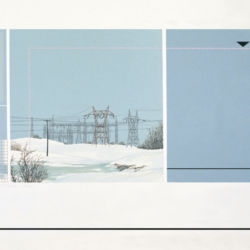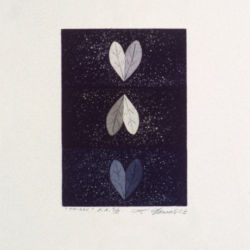Silk Screen
Central to Lauréat Marois’s approach is his striving to attain visual balance between two modes of expression usually seen as opposed, even incompatible: figuration and abstraction.
Marois seeks to reconcile these two modes, in appearance contradictory; in so doing, he makes it possible to use reductive space, instilling it with a more emotional content. Of course, the very process of constructing the image, in serigraphy as is the case here, gives rise to this dichotomy as it were. For example, a subjective element is juxtaposed with the mechanical aspect, i.e., the knowledge component: this is figuration. The figurative element, perceived in its immediate, everyday environment, leads us to reflect on our experience and proposes a theme that will delimit the very organization of the final image. Thus, it is the figurative content (reality) that directs the division and organization of the whole. A reassuring reconciliation of opposites—emotional and rational or natural and cultural. Color is used as an instinctive binder: this is atmosphere.The figurative elements, when perceived, leave the person interpreting the image to choose, offering up an esthetic experience. To generalize, let’s just say that the overall content defies the conventional Western approach to pictorial interpretation. The isolated signs (arrow, triangle , rectangle) throw this interpretation off balance and tend to establish a new connection between the elements contained in the image.
The duality between figuration and abstraction is really a pretext to introduce a question on the possible connections with references , be they human, technological or natural. The aim of the approach is in fact to organize, within the schema used in traditional painting , the information belonging to the visual sphere. More than the acknowledgement of an object to be depicted , this horizontal and vertical organization brings us knowledge of the subject: the relation of the visual work in its very condition of existence.
However , without generalizing an approach, which is really a search, Marois considers that the slow preparation needed to develop the visual sphere, in this case in serigraphy or drawing, leads us to question the image as a system and aims to understand it.
Richard Martel





































